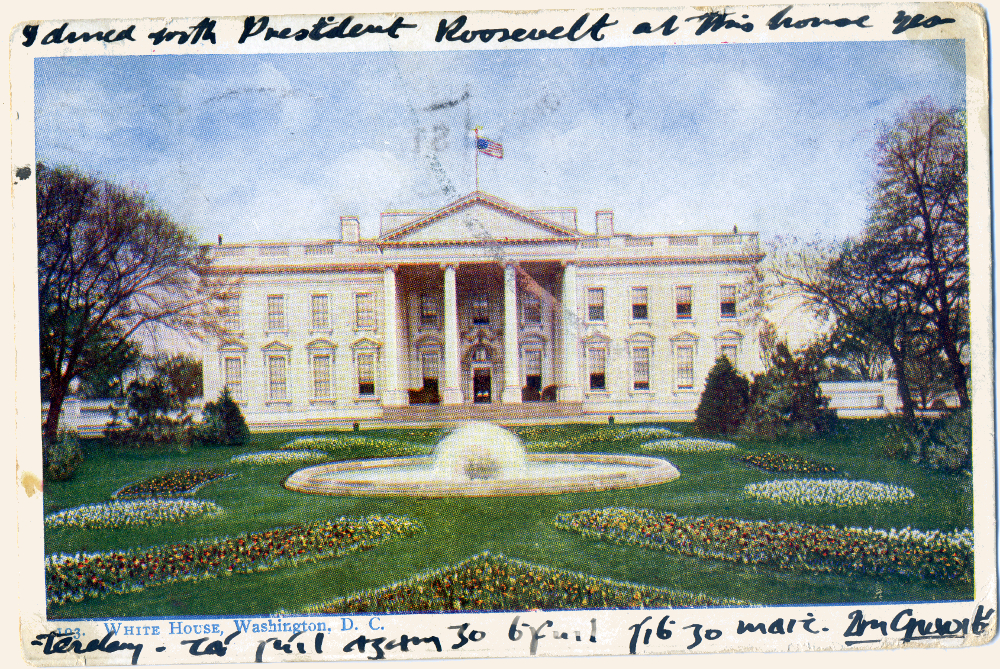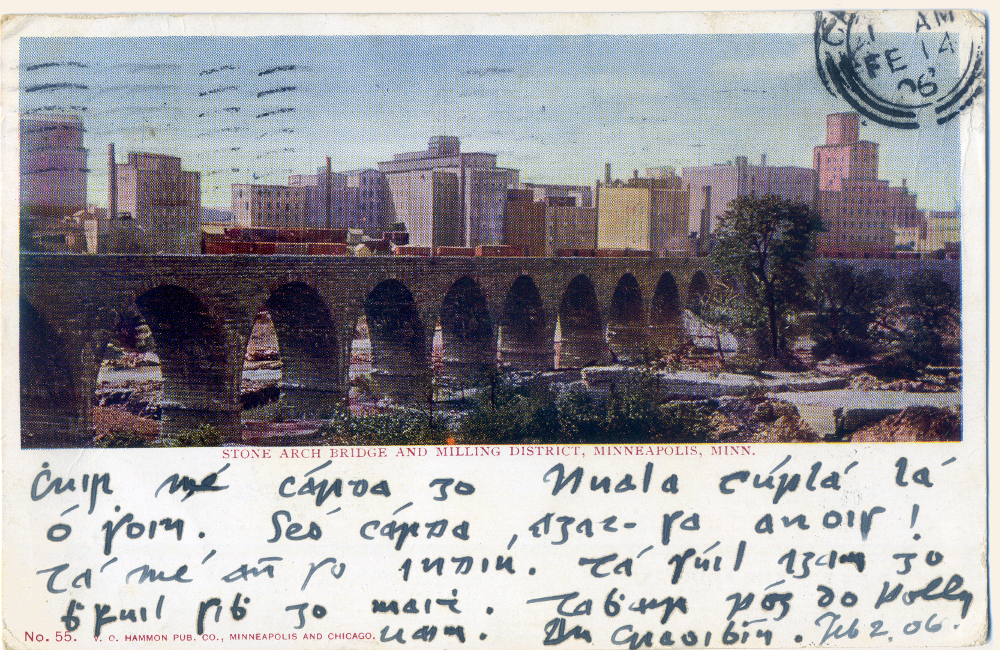21.10.2019
Douglas Hyde’s American Tour, 1905-1906
by Professor Liam Mac Mathúna

© Aidan Heavey Library, Athlone.
Postcard reproduced with the kind permission of the library
Click to enlarge image
The second annual Hyde Lecture Léacht de hÍde took place on 1st October 2019. O rganised by the National University of Ireland and the School of Irish, Celtic Studies and Folklore, UCD, the lecture on the topic ‘Douglas Hyde’s American Tour, 1905-1906’ was given by Professor Liam Mac Mathúna in University College Dublin.
Professor Mac Mathúna spoke about Dr Douglas Hyde who ‘was forty-five years of age when he set sail for America in November 1905 to conduct a coast to coast tour as President of the Gaelic League or Conradh na Gaeilge. His twin aims were to explain the rationale of the language revival movement in Ireland and to raise money to support the activities of the Gaelic League in Irish-speaking districts and throughout the country more generally’.
Professor Mac Mathúna highlighted the success of Douglas Hyde’s American tour, not only financially to the Gaelic League in providing $64,000 to its coffers, but also in terms of how it affected the Irish-American community’s relationship with Ireland as ‘Ideologically, it moved cultural nationalism towards the centre of Irish-American political thinking, at least for a time’.
"Hyde was operating at the highest levels of American society, in its
upper echelons, as is demonstrated clearly by the fact that his tour of the
States included not one, but two visits to the White House to have lunch
with President Theodore Roosevelt."
Professor Mac Mathúna
Throughout this thought provoking and interesting examination of Douglas Hyde’s tour of America, Professor Mac Mathúna offered a tantalising glimpse into Hyde’s personal life and communications with his family by sharing picture postcards sent by Hyde to family and friends. ‘It is interesting to note the contrast in tone between Douglas’s messages and those of Lucy (Hyde’s wife). Douglas tended to be light-hearted, playful, occasionally pedagogical. At times he wrote bilingually, at other times unilingually, in either Irish or English. His wife was more serious, as well as affectionate’. The National Folklore Collection, University College Dublin, holds 60 postcards in its Hyde Collection and 90 postcards are held in the Aidan Heavey Library, Athlone.

© Aidan Heavey Library, Athlone.
Postcard reproduced with the kind permission of the library
Click to enlarge image
Another interesting nugget from Professor Mac Mathúna’s examination of the monetary impact of Hyde’s American tour was ‘Returning to the money trail, it is clear from the last lines of My American Journey that the funds raised in America underwrote the momentous and ultimately successful public campaign to have Irish recognised as an essential subject for matriculation in the new National University of Ireland, established in 1909.’
Professor Mac Mathúna ended his exploration of the tour with a summation on the success and impact of Douglas Hyde’s tour of America – not only for the Gaelic League but for the Irish language and it’s impact on the Irish-American psyche. ‘Hyde’s eight-month-long coast to coast tour of America had more than achieved its aims. Financially, it was a huge success. Ideologically, it had exposed Irish-Americans and Americans generally, to the vigorous forces of cultural nationalism which were sweeping through Ireland at the time … A little surprisingly, perhaps, it had projected Douglas Hyde on to the American scene, not only, as a ground-breaking thinker, but as a leader of the Irish people. The welcome he received from the American populace and their President was akin to that accorded a visiting statesman’.
Professor Regina Uí Chollatáin, Head of the School of Irish, Celtic Studies and Folklore, gave a response to the lecture. She thanked Professor Mac Mathúna for an enthralling and detailed account of Hyde’s American Tour and it s significance:
"As Professor Mac Mathúna has outlined tonight, Hyde’s diaries, correspondence, speeches and newspaper reportage are important in
framing this journey to the foundation of the Irish State in 1922."
Professor Regina Uí Chollatáin
Professor Uí Chollatáin finished by stating ‘Although it is almost one hundred and twenty years since this tour, this type of societal context, which was also employed by many other prominent literary figures serves as an important avenue and link in developing a positive, progressive image and understanding of Ireland in an international milieu. This literary and linguistic story is essential to our understandings of the global village where we now understand the increasingly important role of leaders like Douglas Hyde. A leadership which surpasses many literary, cultural, linguistic and geographical borders.’

© Aidan Heavey Library, Athlone.
Postcard reproduced with the kind permission of the library
Click to enlarge image
Thanking Professor Mac Mathúna for what he described as an absolutely splendid lecture, NUI Chancellor Dr Maurice Manning said ‘ It was vivid, he created a wonderful picture of the United States into which Douglas Hyde came at that stage. Creating a very good picture also, of the Irish influence in the United States at that time. Sometimes, these days, you think that the diaspora is a recent invention, but in fact, Liam’s lecture illustrated just how important the United States was, the influence it had and the financial support it gave to different aspects of the Irish nationalist movement. In this case, Douglas Hyde, was the purest of politicians, in fact as he wasn’t a politician, he was able to rise above politics, which he pretty successfully did throughout his entire career, often in difficult circumstances.
Hyde was preaching a new gospel, the need to de-Anglicise Ireland, the need for the revival, not just of Irish language but of Irish culture, the promotion of Irish literature. It reminds us too, that at that stage, firstly all of the Irish movements, some of them, would be called the physical force movements, others the constitutional nationalists, all looked to the Irish overseas. John Redmond, for example, when he became a young MP, one of his first tasks, was he was sent off to Australia, which was a hell of a long way away in 1904 or 5, out there to raise money for the Irish Party. Éamon de Valera chose to spend time raising support amongst the Irish during crucial stages of our own War of Independence, indicates the centrality of the United States in all of this story.
Douglas Hyde has re-emerged in recent years as a very significant figure, his importance has tended to be minimised for very many years and he was regarded as this nice decent old man, who had no enemies up in the park. But he was much more substantial figure than that as Professor Mac Mathúna’s lecture has shown.
When we invited Liam to give the second Hyde Lecture we knew we were asking the right man, first Liam is editor of Éigse: a Journal of Irish Studies, the successor journal to Hyde’s Lia Fáil. There is no scholar who has been more fully immersed in the subject than Liam has, and we saw that in every sentence here this evening.
"we are particularly grateful for the response Professor Regina
Uí Chollatáin gave to the lecture this evening, it was a lecture in itself"
Dr Maurice Manning
At the event, the Chancellor also launched the publication of the inaugural Léacht de hÍde: ‘The Legacy of Douglas Hyde’ by President Michael D. Higgins.
Douglas Hyde was the first President of Ireland, serving from 1938 to 1945, the first president of Conradh na Gaeilge (the Gaelic League) and the first Professor of Modern Irish in UCD from 1909. In the same year he was appointed as a member of the first Senate of the National University of Ireland of which he was an active member until 1919.
Further information from:
Dr Attracta Halpin
Registrar
National University of Ireland
49 Merrion Square
Dublin 2, D02 V583
Ph: 01 4392424
www.nui.ie
Twitter: @NUIMerrionSq
Professor Regina Uí Chollatáin
Head, UCD School of Irish, Celtic Studies and Folklore
Newman Building, University College Dublin
Belfield
Dublin 4
Ph: 01 7168140
www.ucd.ie/icsf/
Twitter: @UCDScoilGLCB
« Previous























